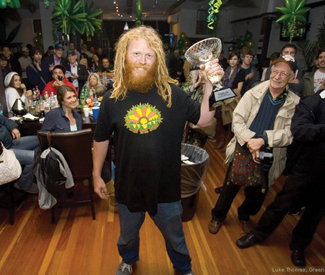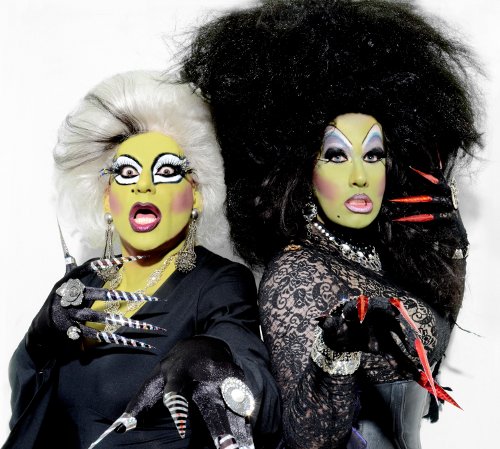Music listings are compiled by Emily Savage. Since club life is unpredictable, it’s a good idea to call ahead or check the venue’s website to confirm bookings and hours. Prices are listed when provided to us. Submit items for the listings at listings@sfbg.com. For further information on how to submit items for the listings, see Picks.
WEDNESDAY 26
ROCK/BLUES/HIP-HOP
Adios Amigo Kimo’s. 9pm, $6.
Boats Brick and Mortar Music Hall. 9pm, $7-$10.
Damir Johnny Foley’s, 243 O’Farrell, SF; www.johnnyfoleys.com. 9pm, free.
Firewind, Arsis, White Wizzard, Nightrage Slim’s. 8pm, $17-$19.
Hank IV, Total B.S. Bottom of the Hill. 8:30pm, free.
Interstellar Grains, Cash Pony, Mean Faces Hemlock Tavern. 9pm, $6.
Yngwie Malmsteen Fillmore. 8pm, $42.
Milagres, Here Here, Genius and the Thieves Rickshaw Stop. 8pm, $10-$12.
Of Mice & Men, Iwrestledabearonce, I See Stars, For the Fallen Dreams Regency Ballroom. 6:30pm, $18.
Hans-Joachim Roedelius, XAMBUCA, Thomas Dimuzio Cafe Du Nord. 8:30pm, $16.
That 1 Guy Great American Music Hall. 9pm, $17.
JAZZ/NEW MUSIC
Cosmo AlleyCats Le Colonial, 20 Cosmo Place, SF; www.lecolonialsf.com; 7-10pm.
Dink Dink Dink, Gaucho, Michael Abraham Amnesia. 7pm, free.
Greg Gotelli Quartet Medjool, 2522 Mission, SF; www.medjoolsf.com. 6-9pm, free.
Jazz organ party Royal Cuckoo, 3202 Mission, SF; www.royalcuckoo.com. 7:30pm, free.
Tony Saunders Yoshi’s. 8pm, $25.
Ricardo Scales Top of the Mark, 999 California, SF; www.topofthemark.com. 6:30pm, $5.
DANCE CLUBS
Booty Call Q-Bar, 456 Castro, SF; www.bootycallwednesdays.com. 9pm. Juanita Moore hosts this dance party, featuring DJ Robot Hustle.
Club Shutter Elbo Room. 10pm, $5. Goth and death rock with DJs Nako, Omar, and Justin.
Full-Step! Tunnel Top. 10pm, free. Hip-hop, reggae, soul, and funk with DJs Kung Fu Chris and Bizzi Wonda.
Kitsune Club Night Mezzanine. 9pm, $15. With Is Tropical, Database, and Beatauce.
Mary Go Round Lookout, 3600 16th St, SF; www.lookoutsf.com. 10pm, $5. Drag with Suppositori Spelling, Mercedez Munro, and Ginger Snap.
Megatallica Fiddler’s Green, 1333 Columbus, SF; www.megatallica.com. 7pm, free. Heavy metal hangout.
No Room For Squares Som., 2925 16th St, SF; (415) 558-8521. 6-10pm, free. DJ Afrodite Shake spins jazz for happy hour.
Temple of Doom Halloween Ruby Skye, 420 Mason, SF; www.rubyskye.com. 9pm, $40. With Zedd, Felguk, and Toro.
Vespa Beat Bliss Bar, 4026 24th St., SF; www.blissbarsf.com. 9pm, free. MSK.fm spins raregrooves, electroswing, and boogie.
THURSDAY 27
ROCK/BLUES/HIP-HOP
Anvil Red Devil Lounge. 8pm, $15.
Bart Davenport, Gypsy Moonlight Band, French Boutik Hemlock Tavern. 9pm, $8.
Del the Funky Homosapien Public Works. 9pm, free with Facebook RSVP.
Felice Brothers,Gill Landry of Old Crow Medicine Show Great American Music Hall. 9pm, $21.
Game Regency Ballroom. 8pm, $35.
Green, Giant Panda Guerilla Dub Squad, Chris Boomer Slim’s. 9pm, $16-$18.
Grouplove, Family of the Year Bimbo’s. 8pm, $16.
Guy Fox, Dreams El Rio. 8pm, $5.
Inu, Hudson Bell, Moldover Bottom of the Hill. 9pm, $10.
John Lawton Trio Johnny Foley’s, 243 O’Farrell, SF; www.johnnyfoleys.com. 9pm, free.
Kyle Leslie 50 Mason Social House, SF; www.50masonsocialhouse.com. 10pm, free.
Little Wings, Bells, Dresses Amnesia. 9pm, $7-$10.
Ryan Montbleau Band, Jason Spooner Cafe Du Nord. 8:30pm, $10-$12.
Muddy Roses Brick and Mortar Music Hall. 8pm, $5-$10.
SBTRKT, New Look, Dials 103 Harriet, SF; www.1015.com. 9pm, $15.
Shiny Toy Guns Rickshaw Stop. 9pm, $15.
Thee Double D’s, Tokyo Raid, Bad Bibles, Culo A Boca Thee Parkside. 9pm, $8.
Tom Zombie & the Braintakers, Third Wheel, No Go’s Knockout. 10:15pm, $7.
JAZZ/NEW MUSIC
Blues Organ Party Royal Cuckoo, 3202 Mission, SF; www.royalcuckoo.com. 7:30pm, free.
Kai Eckhardt Group, Lars Motel Big Band Savanna Jazz, 2937 Mission, SF; www.savannajazz.com. 7:30pm, $10.
Stompy Jones Top of the Mark, 999 California, SF; www.topofthemark.com. 7:30pm, $10.
Tom Lander & Friends Medjool, 2522 Mission, SF; www.medjoolsf.com. 6-9pm, free.
FOLK/WORLD/COUNTRY
Elephant Revival Hotel Utah. 9pm, $12.
Twang! Honky Tonk Fiddler’s Green, 1330 Columbus, SF; www.twanghonkytonk.com. 5pm. Live country music, dancing, and giveaways.
DANCE CLUBS
Afrolicious Elbo Room. 9:30pm, $5. DJs Pleasuremaker and Señor Oz spin Afrobeat, Tropicália, electro, samba, and funk.
Death Guild: Imperative Reaction DNA Lounge. 9pm, $18.
Guilty Pleasures Gestalt, 3159 16th St, SF; (415) 560-0137. 9:30pm, free. DJ TophZilla, Rob Metal, DJ Stef, and Disco-D spin punk, metal, electro-funk, and 80s.
(It’s) All Over Showdown, 10 Sixth St, SF; www.alloversf.tumblr.com. 10pm, free. Punk, indie, EDM, rock, and hip-hop.
Supersonic Bollyhood Café. 10pm, $5. Fly the friendly skies with SF’s Tasty Crew, spinning wold beats from the Balkans, Brazil, Colombia, and more.
Temple of Doom Halloween Ruby Skye, 420 Mason, SF; www.rubyskye.com. 9pm, $40. With Atb.
Thursday Special Tralala Revolution Café, 3248 22nd St, SF; (415) 642-0474. 5pm, free. Downtempo, hip-hop, and freestyle beats by Dr. Musco and Unbroken Circle MCs.
Thursdays at the Cat Club Cat Club. 9pm, $6 (free before 9:30pm). Two dance floors bumpin’ with the best of 80s mainstream and underground with Dangerous Dan, Low Life, and guests.
Tropicana Madrone Art Bar. 9pm, free. Salsa, cumbia, reggaeton, and more with DJs Don Bustamante, Apocolypto, Sr. Saen, Santero, and Mr. E.
FRIDAY 28
ROCK/BLUES/HIP-HOP
Albino, Alma Desnuda, New World Ape Independent. 9pm, $15.
ALO, Fruition Great American Music Hall. 9pm, $22.
AstroZombies, Sean Smith, 3 Leafs El Rio. 9pm, $7.
Back Pages Johnny Foley’s, 243 O’Farrell, SF; www.johnnyfoleys.com. 9pm, free.
Baxtalo Drom Amnesia. 9pm, $7-$10.
Bayonics Elbo Room. 10pm, $10.
Daikaiju, Street Justice, Dalton, Heavy Action Kimo’s. 9:30pm, $7.
Fog City Swampers, Brightlighters, Lemon Party Thee Parkside. 9pm, $2-$5.
Kings of Convenience Fillmore. 9pm, $40.
Eliot Lipp Public Works. 8pm, $20.
Manchester Orchestra, White Denim, Dear Hunter, Little Huricane Regency Ballroom. 7:30pm, $21.
Moccretro, Creepers, Terrible Hemlock Tavern. 9:30pm, $6.
Nobunny, Ty Segall, Apache, Uzi Rash, Zulas Brick and Mortar Music Hall. 9pm.
Please Do Not Fight, Rin Tin Tiger, Debbie Neigher, Owl Paws Bottom of the Hill. 9pm, $10.
Salem 103 Harriet, SF; www.1015.com. 10pm, free with RSVP on www.1015.com.
Secret Secretaries, Water & Bodies, Beta State, Citabria Cafe Du Nord. 9pm, $12.
Too $hort, Vin Sol, DJ Pony P Mezzanine. 9pm, $30.
Totally Enormous Extinct Dinosaurs Rickshaw Stop. 9pm, $15.
Jason Webley, Blackbird Raum Slim’s. 9pm, $14.
Wesley Woo, Los Dos Harmanos 50 Mason Social House, SF; www.50masonsocialhouse.com. 7pm, free.
JAZZ/NEW MUSIC
Black Cat Orchestra Top of the Mark, 999 California, SF; www.topofthemark.com. 9pm, $10.
Bryan Girard Trio Cliff House, 1090 Point Lobos, SF; www.cliffhouse.com. 7pm, free.
Leela James Yoshi’s. 7 and 9pm, $30.
Javon Jackson, Mulgrew Miller, Jimmy Cobb, Peter Washington Yerba Buena Center for the Arts, 701 Mission, SF; www.ybca.org. 8pm, $20.
FOLK/WORLD/COUNTRY
“San Francisco World Music Festival” JCCSF, 3200 California, SF; www.jccsf.org. 8pm, $20.
Riffat Sultana Red Poppy Art House. 8pm, $12-$15.
DANCE CLUBS
Afro Bao Little Baobab, 3388 19th St, SF; (415) 643-3558. 10pm, $5. Afro and world music with rotating DJs including Stepwise, Steve, Claude, Santero, and Elembe.
Afrolicious Halloween with DJ Sabo 1015 Folsom, SF; www.1015.com. 10pm, $10. With Chief Boima, Pleasuremaker, and Senor Oz.
Duniya Dancehall Blue Macaw, 2565 Mission, SF; (415) 920-0577. 10pm, $10. With live performances by Duniya Drum and Dance Co. and DJs dub Snakr and Juan Data spinning bhangra, bollywood, dancehall, African, and more.
“Les Beaux Halloween Ball” DNA Lounge. 9pm, $10. With DJs Kidd Sysko, Ms. Jackson, and Natalie Nuxx.
Old School Dance Party El Rio. 9pm. DJs spinning freestyle, new wave, hip-hop, and old school jams.
Rhythm of the 90s Club Cocomo, 650 Indiana, SF; www.cafecocomo.com. 9pm, $45. Live performance by Turbo B. and old school jams with DJ Essence and DJ Bantik.
Temple of Doom Halloween Ruby Skye, 420 Mason, SF; www.rubyskye.com. 9pm, $40. With DJs Sasha, Spesh, and Spundae.
Vintage Orson, 508 Fourth St, SF; (415) 777-1508. 5:30-11pm, free. DJ TophOne and guest spin jazzy beats for cocktalians.
Zombie Prom Verdi Club, 2424 Mariposa, SF; www.zombiepromsf.com. 9pm, $20. With live music by Slim Jenkins and DJ Rockin Paul.
SATURDAY 29
ROCK/BLUES/HIP-HOP
Angora Debs, Charles Albright, Buk Buk Bigups Hemlock Tavern. 9:30pm, $6.
Black Angel Tikka Masala, 1668 Haight, SF; (415) 626-1756. 6pm, free.
Bay Area Heat Johnny Foley’s, 243 O’Farrell, SF; www.johnnyfoleys.com. 9pm, free.
Damned, Cute Lepers Slim’s. 9pm, $30.
Zach Deputy, Con Brio, DK K-OS Independent. 9pm, $20. Boom Boom Room presents “Halloween Masquerade Bash.”
Quinn Deveaux, Obo Martin, Jugtown Pirates Amnesia. 9pm.
Fastbacks, Muffs, Uncle Joe’s Big ‘Ol Driver Bottom of the Hill. 10pm, $20.
Foreverland, Go Tones Bimbo’s. 9pm, $22.
Go Kart Mozart, Felsen 50 Mason Social House, SF; www.50masonsocialhouse.com. 7pm, free.
Go Time!, Sic Knif Bender’s. 10pm, $5.
Guella Kimo’s. 9pm, $5-$10.
Guvernment, Swillerz, 50 Watt Heavy Thee Parkside. 3pm, free.
Hot Toddies, Ghost & the City, Sun Hop Fat Rickshaw Stop. 9pm, $10.
Meat Hooks and the Vital Organs, Butt Problems, Abrupt Sub-Mission. 9pm, $4-$6.
Mumlers, He’s My Brother and She’s My Sister, Soft White Sixties Brick and Mortar Music Hall. 9pm, $10-$13.
Pierced Arrows, Don’t, Hot Lunch, Hammer Horror Classics Thee Parksides. 9pm, $12.
Planet Booty, Easystreet, Glowing Stars, Hottub DJs Cafe Du Nord. 9:30pm, $12.
Remones Riptide, 3639 Taraval, SF; www.riptidesf.com. 10 and 11:15pm, free.
Simple Plan, Forever the Sickest Kids, Cab, Marianas Trench Regency Ballroom. 8pm, $28.
Strange Boys Clift Hotel, 495 Geary, SF. 9pm, free with RSVP at morganshotelgroup.com/rsvp/clift-sessions.
Tom Shaw Trio featuring Sheelagh Murphy Martuni’s, 4 Valencia, SF; (415) 241-0205. 7pm, $7.
Trentemoller Fillmore. 9pm, $22.50.
Warren Haynes Band Warfield. 9pm, $32-$40.
JAZZ/NEW MUSIC
Dan Zemelman Quartet Red Poppy Art House. 8pm, $12-$20.
Leela James Yoshi’s. 8 and 10pm, $30.
Pomplamoose Yerba Buena Center for the Arts, 701 Mission, SF; www.ybca.org. 9pm, $20.
Wanda Stafford, Benn Bacot, Elly Milder, Loren Means Savanna Jazz, 2937 Mission, SF; www.savannajazz.com. 7:30pm, $10.
FOLK/WORLD/COUNTRY
“San Francisco World Music Festival” JCCSF, 3200 California, SF; www.jccsf.org. 8pm, $20.
Saturday Night Salsa Ramp, 855 Francois, SF; www.facebook.com/therampsf. 5:30pm, $10.
DANCE CLUBS
A Nightmare on 6th Street Halloween Bash Club Six, 60 Sixth St, SF. 9pm. Presented by DeeCee’s Soul Shakedown.
Afro Bao Little Baobab, 3388 19th St, SF; (415) 643-3558. 10pm, $5. Afro and world music with rotating DJs including Stepwise, Steve, Claude, Santero, and Elembe.
Bollyween Elbo Room. 10pm, $10. With Non Stop Bhangra and Black Mahal.
Bootie Halloween Mezzanine. 9pm, $30. With DJs Adrian and Mysterious D, Bootie house band Smash-Up Derby, and special guest DJ Axel.
Club 1994 Halloween Special Vessel, 85 Campton, SF; (415) 252-5017. All ’90s dance party with Jeffrey Paradise and Ava Berlin.
Go Bang! Deco Lounge, 510 Larkin, SF; www.gobangsf.com. 9pm, $5. Costume party with DJs Glenn Rivera, Mattski, Emils, and residents Steve Fabus and Sergio.
Halloween International Ball Hilton Hotel, 333 O’Farrell, SF; www.halloweenball2011-full.eventbrite. 9pm, $25.
Halloween Massive King Street Event Space, 128 King, SF; www.halloweenmassive.com. 8pm, $25.
Temple of Doom Halloween Ruby Skye, 420 Mason, SF; www.rubyskye.com. 9pm, $40. With Cedric Gervais.
Trannyshack: Halloween DNA Lounge. 9:30pm, $25.
Voodoo Eve Lounge, 575 Howard, SF; www.eveloungesf.com. 10pm. With DJs Haylow, Wonway Posibul, mash-ups, top 40, pop, and house.
SUNDAY 30
ROCK/BLUES/HIP-HOP
Alesana, Skylit Drive, Sleeping With Sirens, Attila Regency Ballroom. 6pm, $18.
Anamanaguchi, Starscream, Knife City, Crashfaster Slim’s. 8pm, $12-$14.
Charity and the Jam Band Park Chalet Garden Restaurant, 1000 Great Hwy, SF. 3-5pm.
Gardens Hemlock Tavern 9pm, $7.
Sophie Hunger Brick and Mortar Music Hall. 9pm, $10-$13.
Lemonheads, Shining Twins Independent. 8pm, $22.
Jason Marion Johnny Foley’s, 243 O’Farrell, SF; www.johnnyfoleys.com. 9pm, free.
7 Walkers featuring Bill Kreutzmann, Papa Mali Great American Music Hall. 8pm, $25.
Sic Waiting, Build Them To Break, Advocates, Weekender Kimo’s. 9pm, $5.
Slow Trucks, Yeah Great Fine, Psychic Hiking, One F Cafe Du Nord. 8:30pm, $8-$10.
Warlocks, Fake Your Own Death, Spyrals Bottom of the Hill. 9pm, $10.
JAZZ/NEW MUSIC
Jazz Organ Party with Lavay Smith and Chris Siebert Royal Cuckoo, 3202 Mission, SF; www.royalcuckoo.com. 7:30pm, free.
Kabuki Jazz Cabaret Yoshi’s. 5pm, $25. With Brenda Wong Aoki and Mark Izu.
Bassekou Kouyate, Ngoni BaYerba Buena Center for the Arts, 701 Mission, SF; www.ybca.org. 8pm, $20.
Savanna Jazz Trio Savanna Jazz, 2937 Mission, SF; www.savannajazz.com. 7pm, $5.
Tom Lander & Friends Medjool, 2522 Mission, SF; www.medjoolsf.com. 6-9pm, free.
FOLK/WORLD/COUNTRY
Mash Potangos Studio Gracia, 19 Heron, SF; www.studiogracia.com. 8:30pm.
“San Francisco World Music Festival” JCCSF, 3200 California, SF; www.jccsf.org. 8pm, $20.
Sunday Night Salsa Ramp, 855 Francois, SF; www.facebook.com/therampsf. 5:30pm, $10.
Twang Sundays Thee Parkside. 4pm, free. With Whoa Nellies.
DANCE CLUBS
“All Hallow’s Eve” DNA Lounge. With Decay, BaconMonkey, Joe Radio, and Netik presented by Meat, Death Guild, and Hubba Hubba Revue.
Batcave Club 93, 93 9th St, SF 10pm, $5. Death rock, goth, and post-punk with Steeplerot, XChrisT, Necromos and c_death.
Ceremony 715 Harrison, SF. 5pm, $40. Return of Freemasons, DJs Jamie J Sanchez, Russ Rich, Jay Santos.
Halloween(ish) Dub Mission Elbo Room. 9pm, $6-$8. Dub, roots, and classic dancehall with Spit Brothers, and DJ Sep and J. Boogie.
Jock Lookout, 3600 16th St, SF; www.lookoutsf.com. 3pm, $2. Raise money for LGBT sports teams while enjoying DJs and drink specials.
La Pachanga Blue Macaw, 2565 Mission, SF; www.thebluemacawsf.com. 6pm, $10. Salsa dance party with live Afro-Cuban salsa bands.
Midnight Monster Mayhem Rockit Room, 406 Clement, SF; www.rock-it-room.com. Performances by Eye’z, Smooth D, Omar, Angelo Vivo and more.
Petnation 5 Public Works. 9pm, $5-$10. With Mark Instict, Dcarls, Mochipet, Slayers Club, Skulltrane, and more.
Temple of Doom Halloween Ruby Skye, 420 Mason, SF; www.rubyskye.com. 9pm, $40. With Clublife by Tiesto and Ken Lol.
MONDAY 31
ROCK/BLUES/HIP-HOP
Disasteroid, Mr. Gnome, Juanita and the Rabbit El Rio. 7pm, $5 .
Johnny Legend & His Naked Apes, Beachkrieg, Undertaker & His Pals, DJ Omar Cafe Du Nord. 9pm, $13-$15.
Paper Diamond, Marty Party, Lowriderz 103 Harriet, SF; www.1015.com. 10pm, $15-$20.
7 Walkers featuring Bill Kreutzmann, Papa Mali Great American Music Hall. 8pm, $25.
Soft Moon, Led Er Est, DJs Michael Stock, Josh Cheon Independent. 9pm, $13.
JAZZ/NEW MUSIC
Bossa Nova Tunnel Top, 601 Bush, SF; (415) 722-6620. 8-11:30pm, free. Live acoustic Bossa Nova.
FOLK/WORLD/COUNTRY
Mash Potangos Revolution Cafe, 3248 22nd St, SF; www.classicalrevolution.org. 8pm.
DANCE CLUBS
Bargain Basement Bottom of the Hill. 9pm, free. With DJ Junkdrawer.
Death Guild: Halloween DNA Lounge. 9pm, $5-$13. Gothic, industrial, and synthpop with Joe Radio, Decay, and Melting Girl.
Icee Hot Halloween Spectacular Elbo Room. 9pm, $5. With L-Vis 1990 and Shawn Reynaldo.
M.O.M. Madrone Art Bar. 6pm, free. DJs Timoteo Gigante, Gordo Cabeza, and Chris Phlek playing all Motown every Monday.
“Riptide Halloween Party” Riptide, 3639 Taraval, SF; www.riptidesf.com. 9pm, free. Old school punk with DJs What’s His Fuck and Chaos.
Sausage Party Rosamunde Sausage Grill, 2832 Mission, SF; (415) 970-9015. 6:30-9:30pm, free. DJ Dandy Dixon spins vintage rock, R&B, global beats, funk, and disco at this happy hour sausage-shack gig.
“Subsonic Halloween” Regency Center. 5:45pm, $48. With 15 DJs and acts.
Temple of Doom Halloween Ruby Skye, 420 Mason, SF; www.rubyskye.com. 9pm, $40. With Clublife by Tiesto and Ken Lol.
TUESDAY 1
ROCK/BLUES/HIP-HOP
Jefferson Bergey 50 Mason Social House, SF; www.50masonsocialhouse.com. 10pm, free.
Kathryn Calder Brick and Mortar Music Hall. 9pm, $10-$13.
Chickenfoot, Ponderosa Warfield. 8pm, $45-$57.
Conquest for Death, Boom Boom Kid, Cops! Knockout. 9:30pm, $7.
Family Folk Explosion Elbo Room. 9pm. Day of the Dead celebration.
Field, Portable Sunsets, Beat Broker Rickshaw Stop. 9pm, $12-$14.
Joe Henry, Keefus Great American Music Hall. 8pm, $22.
Mac Miller, People Under the Stairs, Casey Veggies Fillmore. 8pm, $22.50.
Parlotones, Scattered Trees Cafe Du Nord. 9:30pm, $12.
They Are All Dead, He Whose Ox Is Gored, In Aeona Hemlock Tavern. 9pm, $7.
Youth Lagoon, Gross Magic, Parentz Bottom of the Hill. 9pm, $12.
Zola Jesus Independent. 8pm, $15.
JAZZ/NEW MUSIC
Chester Thompson Quartet Yoshi’s. 8pm, $18.
DANCE CLUBS Eclectic Company Skylark, 9pm, free. DJs Tones and Jaybee spin old school hip hop, bass, dub, glitch, and electro.





